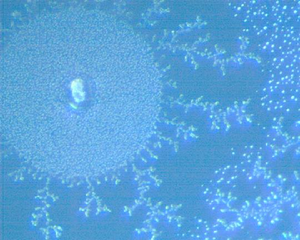M2i research project
Project number: MC3.06244
Title: Photolytic salt formation at oxide surfaces
Acronym: 193 nm
Duration: 2007 - 2009
Project leader: Prof. dr. F. Bijkerk (f.bijkerk@utwente.nl)
Advisor: Prof. dr. A.W. Kleyn
Daily supervisor: Dr. M.A. Gleeson
Researcher: Dr. M. Grecea
Industrial partner: ASML
Aim of the project
Lithographic methods are the backbone of semiconductor manufacturing. Complex optical systems are used to image a mask onto the semiconductor to be processed. Due to the requirement for small dimensions, short wavelength radiation with high photon energy is used (193 nm and shorter). These energetic photons not only induce the desired photochemical reactions at the wafer, but can under certain conditions induce also unwanted reactions within the lithographic equipment. The result can be salt crystal formation that would have a detrimental effect on the performance of the system. At ASML such unwanted photo-induced processes are known and require specific precaution measures such as extreme gas purification. More detailed and specific knowledge about the photo-induced degradation processes at the molecular level is required to study and evaluate different strategies aimed at avoiding unwanted degradation processes. To this end, this project aims to investigate at a fundamental level the mechanisms of salt crystal formation on a variety of relevant surfaces during exposure to gaseous compounds. The work involves characterization of all processes involved in the salt formation at the molecular level. This is accomplished using the methods of surface science in ultra-high vacuum to study the fundamental origin of this technological challenge.

